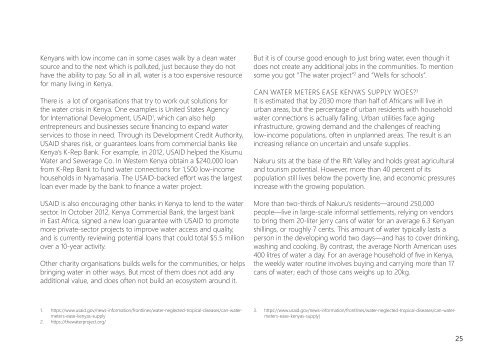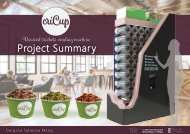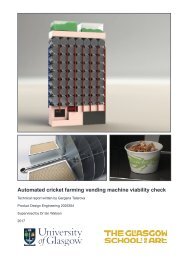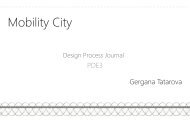Strategy_Waterbike
You also want an ePaper? Increase the reach of your titles
YUMPU automatically turns print PDFs into web optimized ePapers that Google loves.
Kenyans with low income can in some cases walk by a clean water<br />
source and to the next which is polluted, just because they do not<br />
have the ability to pay. So all in all, water is a too expensive resource<br />
for many living in Kenya.<br />
There is a lot of organisations that try to work out solutions for<br />
the water crisis in Kenya. One examples is United States Agency<br />
for International Development, USAID 1 , which can also help<br />
entrepreneurs and businesses secure financing to expand water<br />
services to those in need. Through its Development Credit Authority,<br />
USAID shares risk, or guarantees loans from commercial banks like<br />
Kenya’s K-Rep Bank. For example, in 2012, USAID helped the Kisumu<br />
Water and Sewerage Co. In Western Kenya obtain a $240,000 loan<br />
from K-Rep Bank to fund water connections for 1,500 low-income<br />
households in Nyamasaria. The USAID-backed effort was the largest<br />
loan ever made by the bank to finance a water project.<br />
USAID is also encouraging other banks in Kenya to lend to the water<br />
sector. In October 2012, Kenya Commercial Bank, the largest bank<br />
in East Africa, signed a new loan guarantee with USAID to promote<br />
more private-sector projects to improve water access and quality,<br />
and is currently reviewing potential loans that could total $5.5 million<br />
over a 10-year activity.<br />
Other charity organisations builds wells for the communities, or helps<br />
bringing water in other ways. But most of them does not add any<br />
additional value, and does often not build an ecosystem around it.<br />
But it is of course good enough to just bring water, even though it<br />
does not create any additional jobs in the communities. To mention<br />
some you got ”The water project” 2 and ”Wells for schools”.<br />
CAN WATER METERS EASE KENYA’S SUPPLY WOES? 3<br />
It is estimated that by 2030 more than half of Africans will live in<br />
urban areas, but the percentage of urban residents with household<br />
water connections is actually falling. Urban utilities face aging<br />
infrastructure, growing demand and the challenges of reaching<br />
low-income populations, often in unplanned areas. The result is an<br />
increasing reliance on uncertain and unsafe supplies.<br />
Nakuru sits at the base of the Rift Valley and holds great agricultural<br />
and tourism potential. However, more than 40 percent of its<br />
population still lives below the poverty line, and economic pressures<br />
increase with the growing population.<br />
More than two-thirds of Nakuru’s residents—around 250,000<br />
people—live in large-scale informal settlements, relying on vendors<br />
to bring them 20-liter jerry cans of water for an average 6.3 Kenyan<br />
shillings, or roughly 7 cents. This amount of water typically lasts a<br />
person in the developing world two days—and has to cover drinking,<br />
washing and cooking. By contrast, the average North American uses<br />
400 litres of water a day. For an average household of five in Kenya,<br />
the weekly water routine involves buying and carrying more than 17<br />
cans of water; each of those cans weighs up to 20kg.<br />
1. https://www.usaid.gov/news-information/frontlines/water-neglected-tropical-diseases/can-watermeters-ease-kenyas-supply<br />
2. https://thewaterproject.org/<br />
3. https://www.usaid.gov/news-information/frontlines/water-neglected-tropical-diseases/can-watermeters-ease-kenyas-supply)<br />
25<br />
FinalReport3.indd 25 09/05/2016 10:01:59












